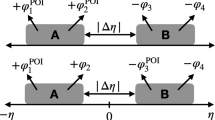Abstract
Earlier fluid dynamical calculations with QGP show a softening of the directed flow while with hadronic matter this effect is absent. On the other hand, we indicated that a third flow component shows up in the reaction plane as an enhanced emission, which is orthogonal to the directed flow. This is not shadowed by the deflected projectile and target, and shows up at measurable rapidities, y CM=1−2. To study the formation of this effect initial stages of relativistic heavy ion collisions are studied. An effective string rope model is presented for heavy ion collisions at RHIC energies. Our model takes into account baryon recoil for both target and projectile, arising from the acceleration of partons in an effective field. The typical field strength (string tension) for RHIC energies is about 5–12 GeV/fm, what allows us to talk about “string ropes”. The results show that QGP forms a tilted disk, such that the direction of the largest pressure gradient stays in the reaction plane, but deviates from both the beam and the usual transverse flow directions. The produced initial state can be used as an initial condition for further hydrodynamical calculations. Such initial conditions lead to the creation of third flow component. Recent v 1 measurements are promising that this effect can be used as a diagnostic tool of the QGP.
Similar content being viewed by others
References
L.P. Csernai, Introduction to Relativistic Heavy Ion Collisions, Wiley, 1994.
A.M. Poskanzer and S.A. Voloshin, Phys. Rev. C58 (1998) 1671.
L.P. Csernai and D. Röhrich, Phys. Lett. B458 (1999) 454.
J. Adams et al. (STAR Coll.), Phys. Rev. Lett. 92 (2004) 062301.
M.D. Oldenburg, Poster presented at QM’04 [nucl-ex/0403007 v2].
M. Gyulassy and L.P. Csernai, Nucl. Phys. A460(1986) 723.
V.K. Magas, L.P. Csernai and D.D. Strottman, Phys. Rev. C64 (2001) 014901 [hep-ph/0010307].
V.K. Magas, L.P. Csernai and D.D. Strottman, Nucl. Phys. A 712 (2002) 167 [hep-ph/0202085].
V.K. Magas, L.P. Csernai and D.D. Strottman, Proc. Int. Conf. New Trend in High-Energy Physics, Crimea, 2001, Yalta, Crimea, Ukraine, September 22–29, 2001, eds. P.N. Bogolyubov and L.L. Jenkovszky, Bogolyubov Institute for Theoretical Physics, Kiev, 2001, pp. 193–200 [hep-ph/0110347].
Author information
Authors and Affiliations
Rights and permissions
About this article
Cite this article
Csernai, L.P., Anderlik, A., Anderlik, C. et al. The 3rd flow component as a QGP signal. Acta Phys. Hung. A 22, 181–186 (2005). https://doi.org/10.1556/APH.22.2005.3-4.2
Received:
Issue Date:
DOI: https://doi.org/10.1556/APH.22.2005.3-4.2



